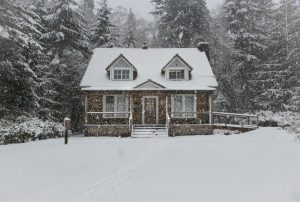
According to a special winter report from LendingTree—which utilized data the U.S. Census Bureau and the National Centers for Environmental Information—took a look at the states with the most, and least, snow and its corresponding affect on home values.
LendingTree specifically analyzed the median value of owner-occupied housing in the states that got the most and least snow using data from December 2022
Key findings, as highlighted by LendingTree, includes:
- There’s a slight positive correlation between home values and the amount of snowfall—but that doesn’t mean expensive real estate is exclusive to snowy parts of the country. Plenty of states with minimal or no snowfall, like Hawaii, boast high median home values.
- With an average of 19.47 inches of snow reported last December, Alaska is the nation’s snowiest state. The median home value of $336,900 in the Land of the Midnight Sun is $16,000 higher than the median home value in the U.S. of $320,900.
- North Dakota, Idaho and Vermont are the next snowiest states in the U.S. The average amount of snow reported in these states in December 2022 was, respectively, 17.49, 16.91 and 16.18 inches, making them and Alaska the only states where the average amount of reported snowfall last December was above 16 inches. At $243,100, $432,500 and $304,700, median home values in these three states vary quite a bit.
- Six states—Alabama, Florida, Hawaii, Louisiana, South Carolina and Texas — reported no snow in December 2022. At $200,900, $209,200, $254,600 and $275,400, Alabama, Louisiana, South Carolina and Texas have median home values lower than the national median. In Florida, meanwhile, the median home value ($354,100) is $33,200 higher than the median home value in the U.S. However, at $820,100, the median value of a home is higher in Hawaii than in any other state, snowy or otherwise.
- Relative to incomes, affordable housing can be found in states both snowy and not. For example, with a median home value to median household income ratio of 3.82, homes in Alaska are relatively affordable compared to the national median home value to median household income ratio of 4.29. Despite its significantly different climate, Texas’ median home value to median household income ratio of 3.81 is nearly identical to Alaska’s.
By the numbers, the states with the most snow include:
1. Alaska
- Average reported snowfall in December 2022: 19.47 inches
- Median home value: $336,900
- Median household income: $88,121
- Median home value to median household income ratio: 3.82
2. North Dakota
- Average reported snowfall in December 2022: 17.49 inches
- Median home value: $243,100
- Median household income: $71,970
- Median home value to median household income ratio: 3.38
3. Idaho
- Average reported snowfall in December 2022: 16.91 inches
- Median home value: $432,500
- Median household income: $72,785
- Median home value to median household income ratio: 5.94
4. Vermont
- Average reported snowfall total in December 2022: 16.18 inches
- Median home value: $304,700
- Median household income: $73,991
- Median home value to median household income ratio: 4.12
5. Minnesota
- Average reported snowfall total in December 2022: 14.20 inches
- Median home value: $314,600
- Median household income: $82,338
- Median home value to median household income ratio: 3.82

According to LendingTree, if you live in, or plan to move to one of these snowiest states, you should consider snow-related costs.
For example, not only can severe cold and snow cause major home damage like burst pipes and flooding, but intense snowfall can also render travel virtually impossible. In extreme cases, being snowed in can prevent someone from important tasks like going to the grocery store or even getting to a hospital for medical attention.
LendingTree also warns that its not just the money that’s involved with snow removal, but the time investment in it too, such as having to wake up early to shovel your driveway, or the time and money it takes to research, buy, and assemble a snowblower.
Click here for the full report from LendingTree, which ranks all 50 states.

 theMReport.com Your trusted source for mortgage banking news
theMReport.com Your trusted source for mortgage banking news








